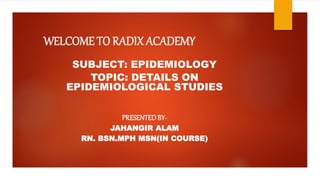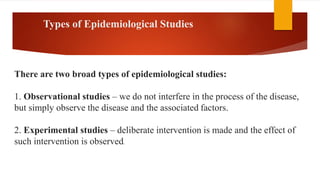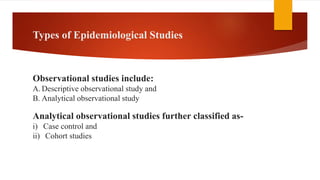Class-2 Epidemiological studies.pptx
- 1. WELCOME TO RADIX ACADEMY SUBJECT: EPIDEMIOLOGY TOPIC: DETAILS ON EPIDEMIOLOGICAL STUDIES PRESENTEDBY- JAHANGIR ALAM RN. BSN.MPH MSN(IN COURSE)
- 2. Types of Epidemiological Studies There are two broad types of epidemiological studies: 1. Observational studies – we do not interfere in the process of the disease, but simply observe the disease and the associated factors. 2. Experimental studies – deliberate intervention is made and the effect of such intervention is observed.
- 3. Types of Epidemiological Studies Observational studies include: A. Descriptive observational study and B. Analytical observational study Analytical observational studies further classified as- i) Case control and ii) Cohort studies
- 4. Experimental studies There are three main types of experimental studies. 1. Randomized controlled trials (RCT) – uses patients as units of study, mostly for assessing a new therapy. 2. Field trials – uses healthy individuals as units of study, mostly for assessing preventive agents like vaccines. 3. Community trials – uses communities as units of study for assessing community based interventions like health status in villages with a training program versus in those without.
- 5. Observational and Case Control Study Observational study ? The disease distribution in a community is described in terms of Time, Place and Person. ?This study can give clues about the ‘risk factors’ and the cause.
- 6. Case – control study This is a retrospective study. I. A group of ‘cases’ of a disease is assembled. II. Another group of matched ‘controls’ (free from disease) is assembled. III. The history of exposure to the suspected risk factor is ascertained in all the members of both the groups IV. The prevalence of the exposure among the cases is compared with that in the controls.
- 7. Case – control study cont.…. V. Factors which are significantly more in the cases group as compared to the control are reaffirmed as the risk factors. -By same argument, factors which are significantly higher in the controls are noted as the possible protective factors. VI. Odd’s ratio (OR) is calculated in case – control studies to estimate the risk associated with each risk factor
- 8. Cohort study: A cohort study is a particular form of longitudinal study that samples a cohort (a group of people who share a defining characteristic, typically those who experienced a common event in a selected period, such as birth or graduation), performing a cross-section at intervals through time. It is a type of panel study where the individuals in the panel share a common characteristic. Examples of cohort studies are (1) Framingham Cohort study, (2) Swiss HIV Cohort study, and (3) The Danish Cohort study of psoriasis and depression. These studies may be prospective, retrospective, or a combination of both of these types.
- 9. Sample question Which type of study is cheaper and faster? ? A. Retrospective study. ? B. Prospective study.
- 10. Cross sectional study cont.… A cross-sectional study is a type of research design in which investigator collect data from many different individuals at a single point in time.
- 11. Longitudinal study In a longitudinal study, researchers repeatedly examine the same individuals to detect any changes that might occur over a period of time. Longitudinal studies are a type of correlational research in which researchers observe and collect data on a number of variables without trying to influence those variables. One of the longest longitudinal studies, the Harvard Study of Adult Development, has been collecting data on the physical and mental health of a group of Boston men for over 80 years!
- 12. Cohort study cont.… I. One group of people exposed to the suspected RF is identified. This is the ‘Exposure cohort’ II. Another group of people similar to the exposure cohort, but DEFINITELY NOT EXPOSED are identified. – This is the ‘Control or Non-exposed cohort’. III. The groups are similar except for the ‘exposure’ to the risk factor. ? It is made sure that none of the members in both the groups have the disease under investigation IV. Both the cohorts are regularly followed up for a definite period and examined for development of the disease at regular intervals
- 13. Cohort study cont.…. V. If the incidence of the disease is significantly higher in the exposed cohort, the association is confirmed VI. Relative Risk (RR) is calculated in cohort studies to estimate the risk associated with each risk factor Formula of Relative Risk:
- 15. Field Study ? Mainly for vaccines or preventive agents ? Hence units of study are HEALTHY individuals or those without disease ? The incidence among vaccinated is compared with the incidence among non vaccinated ? The two groups i.e. vaccinated and non vaccinated can not usually be decided by randomization ? Hence they may not be exactly comparable
- 16. Community Trial ? Some communities e.g. districts may have the public health intervention like a new method of water purification ? Other districts continue with the older methods ? The incidence of water-borne disease can be compared among these districts The usual sequence of progress from one type of study to the next, as the evidence of an association builds up is as follows: i. Descriptive study of the disease ii. Case control study using the diagnosed cases and confirmed controls iii. Cohort study: using ‘exposed’ and ‘un –exposed’ cohorts
- 17. Epidemiological Triad ? The epidemiological triad or epidemiological triangle is a traditional model to explain how infectious diseases are caused and transmitted. The model is very simple and represents a high- concept, bird’s-eye view of infectious diseases.
- 20. Sample question 1. A key features of a cross-sectional study are- a. It usually provides information on prevalence rather than incidence b. It is limited to health exposures and behaviors rather than health outcomes c. It is more useful for descriptive epidemiology than it is for analytic epidemiology d. It is synonymous with survey. 2. A cohort study differs from a case-control study in that- a. Subjects are enrolled or categorized on the basis of their exposure status in a cohort study but not in a case-control study b. Subjects are asked about their exposure status in a cohort study but not in a case-control study c. Cohort studies require many years to conduct, but case-control studies do not
- 21. Sample question 3. The hallmark feature of an analytic epidemiologic study is: (Choose one best answer) a. Use of an appropriate comparison group b. Laboratory confirmation of the diagnosis c. Publication in a peer-reviewed journal d. Statistical analysis using logistic regression 4. A study in which children are randomly assigned to receive either a newly formulated vaccine or the currently available vaccine, and are followed to monitor for side effects and effectiveness of each vaccine, is an example of which type of study? a. Experimental b. Observational c. Cohort d. Case-control e. Clinical trial
- 22. Answer to the sample questions ? Answer to question no 1: a, c, and d. ? Answer to question no 2: a ? Answer to question no 3: a ? Answer to question no 4: a, e
- 23. Types of reservoir Human reservoir When organism lodges in human body Animal reservoir When organism lodges in animals other then human body. Reservoir in non living things When organism exist in non living things and is able to spread disease.
- 24. Stages of disease ? A. Stage 1; Incubation period: Time between exposure to a pathogen and apparent of features. ? B. Stage 2; Prodromal period: Increasing the number of infectious agent and immune system start to reacting with them. ? C. Stage 3; Acute period: rapid multiplication of pathogen. ? D. Stage 4; Convalescence period: The patient may recover gradually but may serve as a source of infection.
- 26. Thanks to All


























